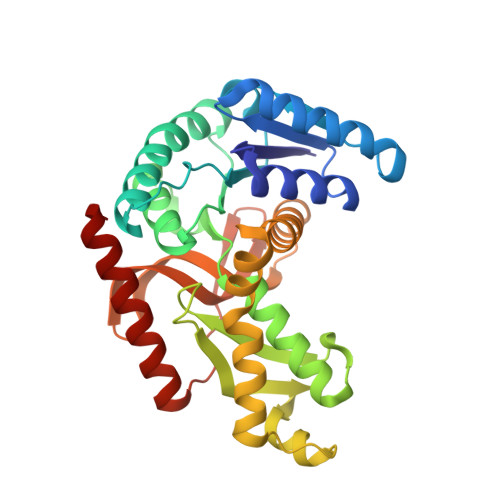Sampling the conformational energy landscape of a hyperthermophilic protein by engineering key substitutions.
Colletier, J.P., Aleksandrov, A., Coquelle, N., Mraihi, S., Mendoza-Barbera, E., Field, M., Madern, D.(2012) Mol Biol Evol 29: 1683-1694
- PubMed: 22319152
- DOI: https://doi.org/10.1093/molbev/mss015
- Primary Citation of Related Structures:
3ZZN, 4A73 - PubMed Abstract:
Proteins exist as a dynamic ensemble of interconverting substates, which defines their conformational energy landscapes. Recent work has indicated that mutations that shift the balance between conformational substates (CSs) are one of the main mechanisms by which proteins evolve new functions. In the present study, we probe this assertion by examining phenotypic protein adaptation to extreme conditions, using the allosteric tetrameric lactate dehydrogenase (LDH) from the hyperthermophilic bacterium Thermus thermophilus (Tt) as a model enzyme. In the presence of fructose 1, 6 bis-phosphate (FBP), allosteric LDHs catalyze the conversion of pyruvate to lactate with concomitant oxidation of nicotinamide adenine dinucleotide, reduced form (NADH). The catalysis involves a structural transition between a low-affinity inactive "T-state" and a high-affinity active "R-state" with bound FBP. During this structural transition, two important residues undergo changes in their side chain conformations. These are R171 and H188, which are involved in substrate and FBP binding, respectively. We designed two mutants of Tt-LDH with one ("1-Mut") and five ("5-Mut") mutations distant from the active site and characterized their catalytic, dynamical, and structural properties. In 1-Mut Tt-LDH, without FBP, the K(m)(Pyr) is reduced compared with that of the wild type, which is consistent with a complete shifting of the CS equilibrium of H188 to that observed in the R-state. By contrast, the CS populations of R171, k(cat) and protein stability are little changed. In 5-Mut Tt-LDH, without FBP, K(m)(Pyr) approaches the values it has with FBP and becomes almost temperature independent, k(cat) increases substantially, and the CS populations of R171 shift toward those of the R-state. These changes are accompanied by a decrease in protein stability at higher temperature, which is consistent with an increased flexibility at lower temperature. Together, these results show that the thermal properties of an enzyme can be strongly modified by only a few or even a single mutation, which serve to alter the equilibrium and, hence, the relative populations of functionally important native-state CSs, without changing the nature of the CSs themselves. They also provide insights into the types of mutational pathways by which protein adaptation to temperature is achieved.
- Dynamop Group, Institut de Biologie Structurale J.-P. Ebel, CEA CNRS UJF, UMR 5075, Grenoble cedex 01, France.
Organizational Affiliation:

















